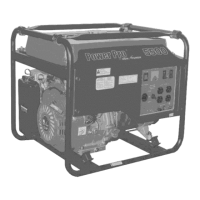GENERATOR COMPONENTS
Please familiarize yourself with the locations and functions of the various components
and controls of your generator.
7 8 9 10 t 1
1
2
4
17 _8 !5
t2
!4
19
(1) Choke Rod- Adjusts the amount of air let into
the engine.
(2) Air cleaner- a removable, cleanable, sponge-like
element that limits the amount of dirt pulled into the
engine.
(3) Fuel valve- Allows fuel to enter engine.
(4) Fuel Filter Cup- Traps dirt and water fi:om fuel
before it enters the engine.
(5) Recoil Starter- Pull-cord l_r starting engine.
(6) Oil Fill and Dipstick- Location l_r checking and
filling engine oil.
(7) Fuel Gauge- Indicates the amount of fuel in the
tank.
(8) Fuel (ap- Access to the fuel tank for adding
fuel.
(9) Engine Switch- Used to start/stop engine.
(10) Volt Meter- Provides reading of voltage output.
(11) Circuit Breakers- Reset switches that protects the
generator I?oln electrical overload.
(12) 120 Volt AC Receptacles- Use to connect
electrical devices that run 120 Volt, 60 Hz, single phase,
AC current.
(13) Ground Terminal- Connect grounding wires here
to properly ground unit.
(14) Protector-AC output protection when over current.
(15) 12 Volt DC Terminal- Use I_r charging 12 Volt
automotive-type batteries only.
(16) Voltage switch- Use to switch between 120 and
240 voltage.
(17) 240 Volt AC Receptacle- Use to connect electrical
devices that run 240 Volt, 60 Hz, single phase, AC
current.
(18) Muffler- Reduces engine noise.
(19) Spark plug- Provides proper engine ignition.

